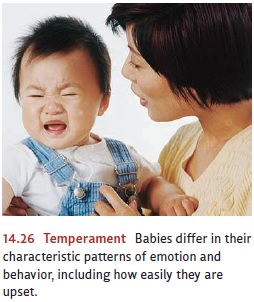Chapter: Psychology: Development
The Role of Temperament - Socioemotional Development in Infancy and Childhood
THE
ROLE OF TEMPERAMENT
The
differences in children’s attachment styles can have important implications for
later development. But why do
children differ in this way? And in what other ways do children differ? The
answers begin before birth.
Even
in the uterus, some babies kick and move around more than others, and these
differences in activity level continue after the child is born. Likewise, some
babies are easily upset; others seem far calmer. Some babies are fearful when
they encounter a novel stimulus; others show little fear and seem to constantly
seek out new stimulation. Some babies seem to adjust easily to new
circumstances; others seem upset by even small changes in their routine or
surroundings (Figure 14.26).
Scholars
refer to these variations as differences in temperament,
defined as the char-acteristic pattern of emotion and behavior that is evident
from an early age and deter-mined to a considerable extent by genetic patterns
(Chess & Thomas, 1982; Rothbart & Bates, 1998; Thomas & Chess,
1984). According to some theories, the child’s tempera-ment provides the core
of his developing personality.
There
has been debate, however, over how to describe an infant’s temperament. One
categorization scheme distinguishes “easy babies,” who are playful and adapt
quickly to new circumstances; “difficult babies,” who are irritable and try to
withdraw from new sit-uations; and “slow to warm up babies,” who are low in
their activity level and moderate in most of their responses (Chess &
Thomas, 1982). A different scheme categorizes babies in terms of three
dimensions—roughly how active the baby is, whether the baby is generally
cheerful or not, and whether the baby seems to have good control over itself
(Rothbart & Bates, 1998). No matter how temperament is categorized, though,
it seems to be heavily influenced by genetics. We know this because identical
twins (who have the same genome) tend to have very similar temperaments;
fraternal twins (who share only half their genes) tend to be less similar in
temperament (A. Buss & Plomin, 1984).

Related Topics